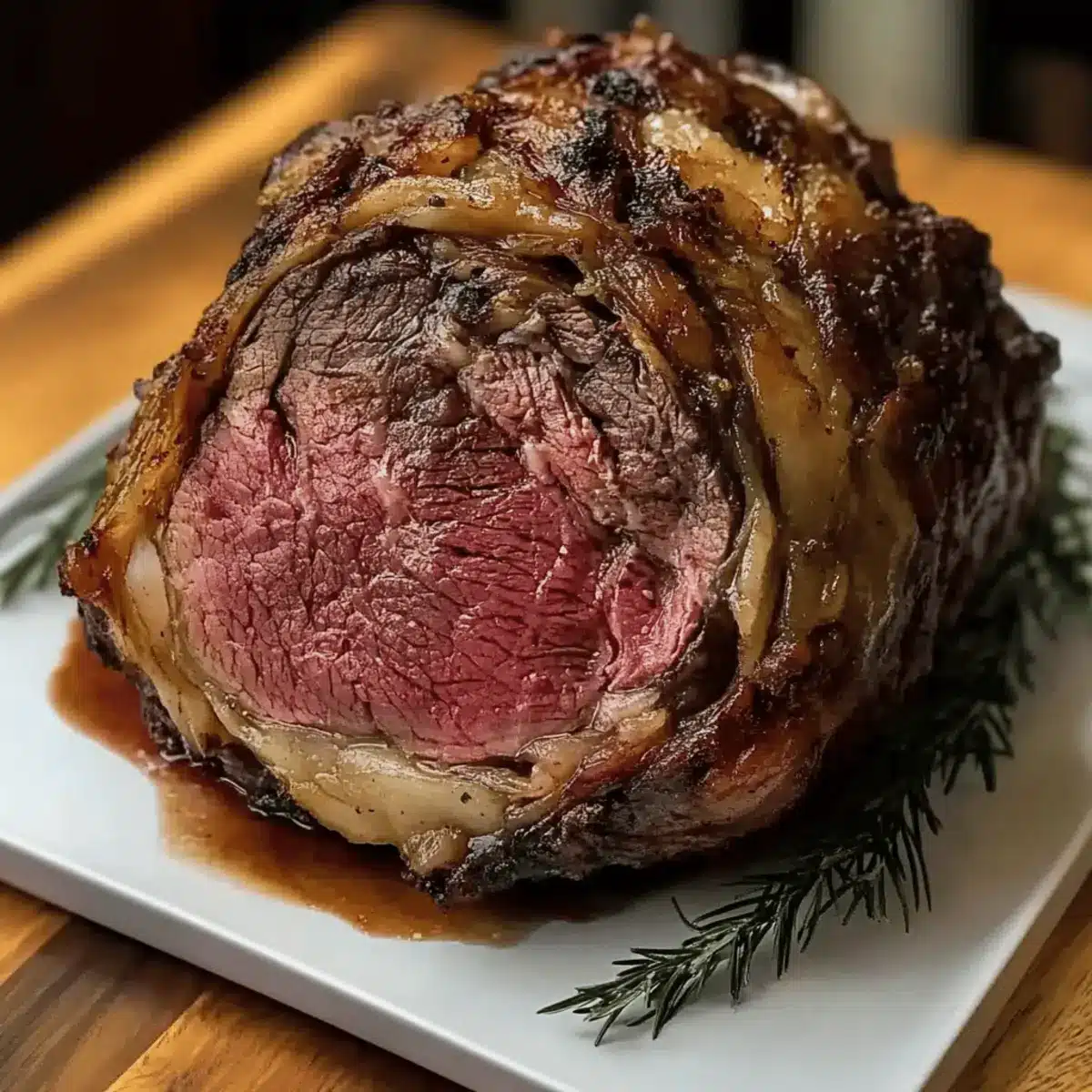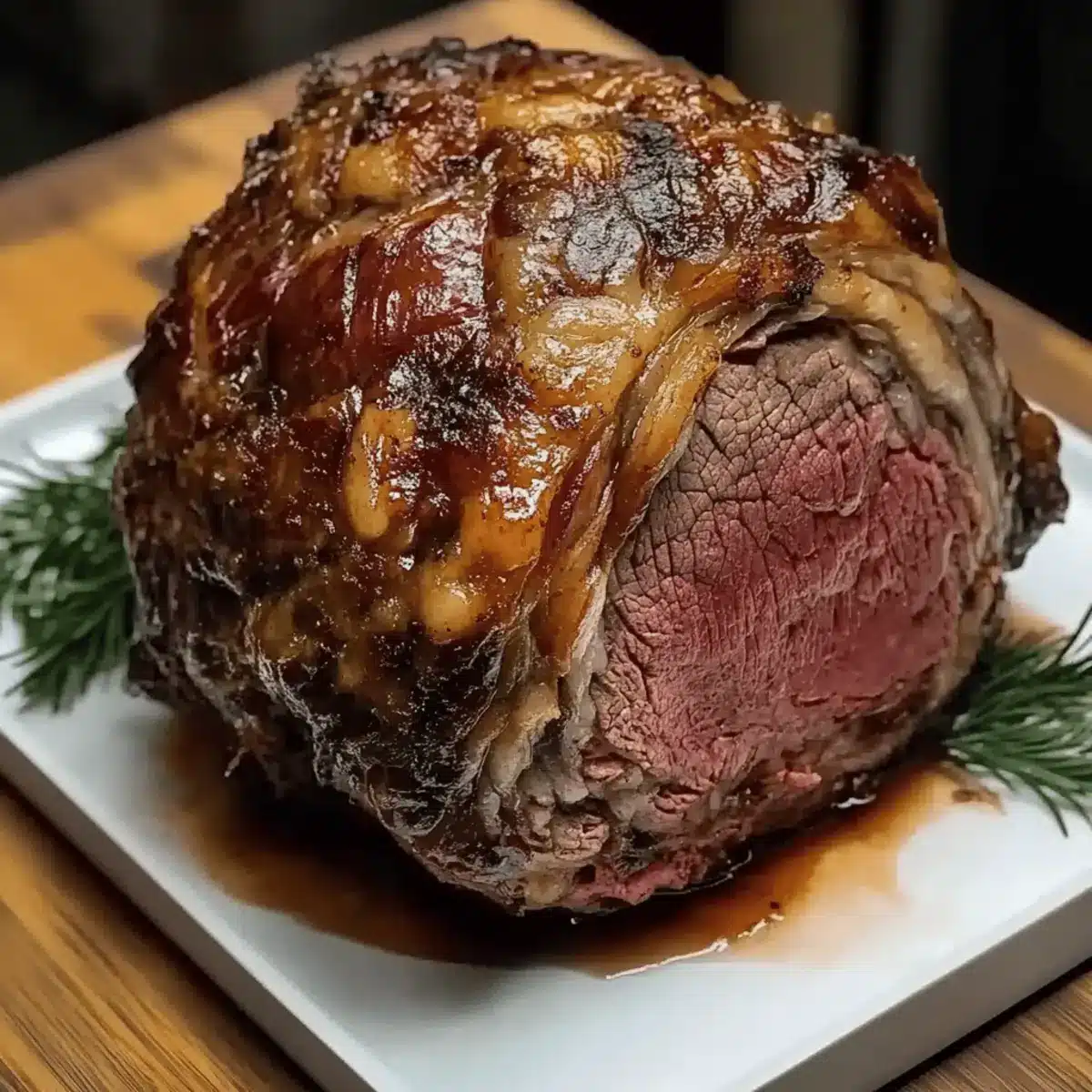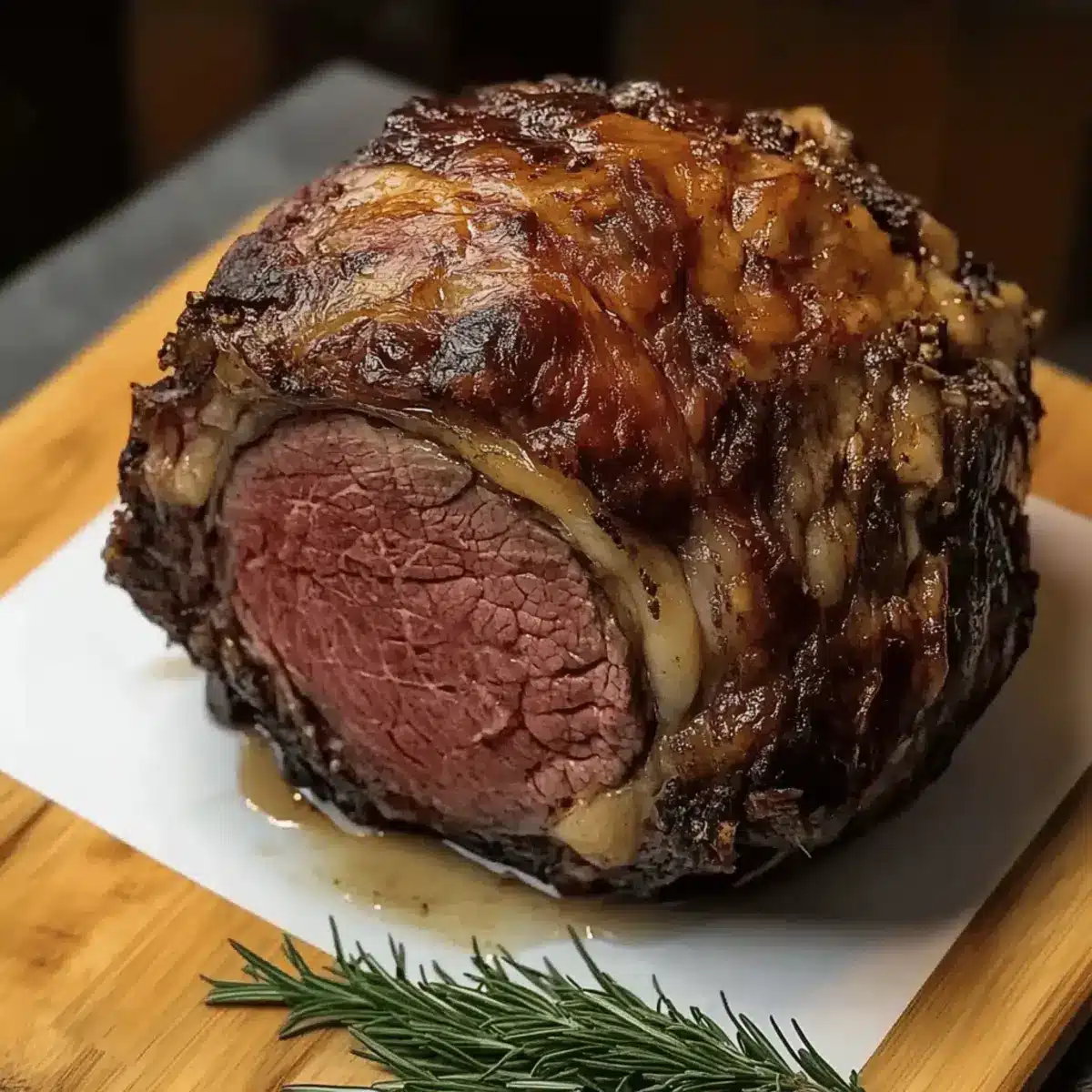The aroma of a Classic Christmas Prime Rib wafting through the house is nothing short of magical—it’s a moment that transforms ordinary holiday gatherings into cherished memories. As a proud home chef, I love serving this stunning centerpiece, seamlessly melding tradition and flavor in a way that wows my family and friends. This recipe features an easy-to-follow method, ensuring the roast turns out perfectly juicy and tender every time, making it a true crowd-pleaser. Not only is this prime rib irresistibly rich in flavor, but it also pairs beautifully with homemade au jus and zesty horseradish sauce for that extra kick. Ready to elevate your festive feast? Let’s dive in and make this holiday season unforgettable!

Why is Prime Rib the Ultimate Holiday Dish?
Showstopper Centerpiece: A beautifully cooked prime rib roast not only looks impressive on your dining table but also becomes the highlight of your festive get-togethers.
Rich, Juicy Flavor: The marbling in a prime rib creates unparalleled juiciness, making each bite a flavor explosion that will have your guests raving.
Simple Preparation: With just a few hours in the oven and straightforward seasoning, you can achieve restaurant-quality perfection at home.
Perfect for Gatherings: This dish serves many, allowing friends and family to bond over delicious portions, making it an ideal choice for large get-togethers.
Endless Pairing Options: From creamy mashed potatoes to roasted Brussels sprouts, the versatility of sides is endless! Consider adding a rich Beef Stew Cozy to your holiday menu for that extra warmth.
Elevate your Christmas dinner with this classic recipe that promises to leave appetites satisfied and hearts full.
Classic Christmas Prime Rib Ingredients
For the Roast
- Prime Rib Roast – Select “Prime” or “Choice” grade for maximum flavor and tenderness.
- Kosher Salt – Use about 1% of the meat’s weight to dry brine and enhance flavor.
- Olive Oil – Ideal for browning; can be swapped for another high-heat oil.
For the Au Jus
- Meaty Bones (e.g., oxtails, neck bones) – Their richness deepens the au jus flavor; beef shank is a valid substitute.
- Garlic (5 cloves) – Fresh garlic adds delightful depth; essential for a tasty au jus.
- Carrots (2 large, chopped) – Sweetness from carrots balances the savory flavors of the sauce.
- Celery (3 ribs, chopped) – Aromatic celery contributes a comforting background note.
- Onion (1 chopped) – Sweetness and complexity in the sauce; shallots work as a great alternative.
- Tomato Paste (1 tbsp) – Intensifies the sauce’s flavor profile beautifully.
- Dry Red Wine (1/2 cup) – Perfect for deglazing and enhancing flavor; replace with beef broth if preferred.
- Low-sodium Beef Stock (6 cups) – The heart of the au jus; homemade is ideal, but store-bought works wonderfully too.
- Thyme (2 sprigs) & Bay Leaf – These herbs brighten the flavor of your homemade au jus.
For the Horseradish Sauce
- Sour Cream (1 cup) – Provides a creamy base for the sauce; Greek yogurt can be a lighter option.
- Prepared Horseradish (5 tbsp) – Adds zesty kick; adjust to your heat preference.
- Dijon Mustard (1 tbsp) – Subtly sharp, elevating the sauce’s overall flavor.
- Worcestershire Sauce (2 tsp) – A hint of umami that rounds out your sauce perfectly.
- Mayonnaise (2 tbsp) – Richness to balance the spiciness of horseradish.
This Classic Christmas Prime Rib recipe showcases flavors that are festive and rich, creating an unforgettable dining experience that your loved ones will cherish.
Step‑by‑Step Instructions for Classic Christmas Prime Rib
Step 1: Prepare Roast
Begin by seasoning your prime rib generously with kosher salt, allowing it to rest in the refrigerator for at least 24 hours. The day of cooking, take the roast out to sit at room temperature for 5-6 hours; this critical step ensures even cooking throughout the Classic Christmas Prime Rib.
Step 2: Preheat Oven
Preheat your oven to 250°F (120°C) for a slow, even roast that maintains the juices within the meat. This gentle cooking temperature will allow the prime rib to develop a beautiful crust while producing a tender, succulent interior.
Step 3: Prepare Au Jus
In a large pot, heat a splash of olive oil over medium heat and brown meaty bones until they’re nicely caramelized. Next, add in chopped garlic, carrots, celery, and onion, cooking them until softened—about 5-7 minutes. Stir in the tomato paste, then deglaze the pot with red wine, scraping up any delicious brown bits, before adding stock, thyme, and a bay leaf.
Step 4: Roast Prime Rib
Insert a meat thermometer into the thickest part of the prime rib and place it in the oven. Roast until the internal temperature reaches 115°F for rare or 120°F for medium-rare, which typically takes around 3 hours. Keep an eye on the temperature to ensure it reaches perfection for your Classic Christmas Prime Rib.
Step 5: Rest the Meat
Once your roast reaches the desired doneness, remove it from the oven and tent it with foil. Let it rest for 20-30 minutes—this crucial step allows the juices to redistribute, resulting in a flavorful and juicy prime rib that’s perfect for serving.
Step 6: Broil for Crust
After the rest period, switch your oven to broil. Place the roast back in for 1-2 minutes on each side, watching closely to achieve a crispy, golden crust. This additional step enhances the visual appeal and adds a delicious texture to your Classic Christmas Prime Rib.
Step 7: Strain Au Jus
Once the roast is complete, strain the au jus from the pot to separate the liquid from the solids. If you wish, reduce the liquid over medium heat to concentrate the flavors further. Make sure to skim off any excess fat for a smooth sauce that beautifully complements the prime rib.
Step 8: Prepare Horseradish Sauce
In a bowl, combine sour cream, prepared horseradish, Dijon mustard, Worcestershire sauce, and mayonnaise until smooth. This zesty horseradish sauce will add a delightful kick when served alongside your Classic Christmas Prime Rib, enhancing its rich flavors.
Step 9: Serve
Finally, slice the prime rib into generous portions, presenting it on a warmed platter for the best aesthetic. Serve your delicious roast with the beautifully strained au jus and your homemade horseradish sauce, creating a memorable centerpiece for your festive feast.

What to Serve with Classic Christmas Prime Rib
When you’re crafting a festive meal, the right accompaniments will elevate your Classic Christmas Prime Rib experience to new heights.
-
Creamy Mashed Potatoes: The velvety texture of mashed potatoes pairs perfectly with the rich flavors of prime rib and au jus, creating a comforting base for each bite.
-
Roasted Brussels Sprouts: Their slightly crispy edges and caramelized sweetness balance the savory meat, offering a delightful contrast in flavors.
-
Yorkshire Puddings: This classic British side is perfect for soaking up the delicious au jus, making every spoonful a treat. Light and airy, they add an elegant touch to your feast.
-
Garlic Butter Green Beans: A fresh and crunchy side, the bright green beans tossed in garlic butter add a vibrant pop of color and taste, enhancing your meal’s overall appeal.
-
Glazed Carrots: Sweet glazed carrots complement the savory roast, providing a touch of sweetness and a beautiful bright hue to your plate.
-
Red Wine: A bold Pinot Noir matches the rich flavors of the prime rib, while its acidity cuts through the meat’s richness, enhancing the dining experience.
-
Chocolate Mousse: Finish the meal on a sweet note with a silky chocolate mousse. Its lightness and richness provide a perfect contrast to the hearty flavors of your main dish.
These pairings will not only satisfy but also help weave a tapestry of flavors that highlight the festive spirit of your holiday gathering.
How to Store and Freeze Classic Christmas Prime Rib
Fridge: Store leftover prime rib in an airtight container for up to 3 days. Be sure to cool the meat completely before sealing to maintain freshness.
Freezer: Wrap slices tightly in plastic wrap and then in foil to prevent freezer burn. It can be frozen for up to 3 months without losing much flavor or texture.
Reheating: Gently reheat in the oven at 300°F (150°C) with a splash of au jus or broth to keep the meat moist. Avoid using high heat to preserve tenderness.
Leftover Ideas: Use any classic Christmas prime rib leftovers in sandwiches or salads for a delicious next-day meal, ensuring the flavor lives on!
Make Ahead Options
Planning your Classic Christmas Prime Rib in advance is a fantastic way to simplify your holiday cooking! You can season the prime rib with kosher salt and let it rest in the refrigerator for up to 24 hours to enhance flavor through dry brining. Additionally, you can prepare the au jus and store it in the refrigerator for up to 3 days—just reheat gently before serving to maintain its rich flavor. When you’re ready to cook, simply take the meat out to sit at room temperature for 5-6 hours, roast it as directed, and don’t forget to let it rest. By prepping ahead, you’ll enjoy a stress-free holiday dinner with a stunning centerpiece that’s just as delicious!
Classic Christmas Prime Rib Variations
Customize your Classic Christmas Prime Rib to create a new favorite for your festive gatherings!
- Herb Infusion: Add rosemary or thyme to the dry rub for additional aromatic layers, enticing your senses even more.
- Wine Swap: Omit the red wine in the au jus and substitute with beef broth for a kid-friendly, alcohol-free option.
- Mushroom Sauce: Instead of horseradish sauce, whip up a creamy mushroom sauce by sautéing mushrooms in butter—umami goodness awaits!
- Garlic Level Up: Infuse roasted garlic into your horseradish sauce for a creamy, slightly sweet twist that pairs exquisitely with the savory meat.
- Spicy Kick: Mix in some chili flakes to the horseradish sauce to amp up the heat and tantalize those taste buds!
- Smoky Flavor: Introduce a touch of smoked paprika into your seasoning mix for a delicious smoky dimension that elevates your prime rib’s flavor profile.
- Go Lean: Swap out the prime rib for a tenderloin roast for a leaner option that still promises festive delight.
- Vegetarian Alternative: Serve a hearty stuffed butternut squash as a centerpiece alongside the prime rib for vegetarian guests; it’ll balance the menu beautifully!
As you embark on this delicious journey, consider pairing your prime rib with mouthwatering sides like creamy mashed potatoes or the warm and hearty flavors of a classic Beef Stew Cozy. Enjoy the wonderful process of creating cherished memories around the dinner table!
Expert Tips for Classic Christmas Prime Rib
- Room Temperature Rule: Ensure the prime rib sits at room temperature for 5-6 hours before roasting. This step prevents uneven cooking and guarantees a juicy Classic Christmas Prime Rib.
- Quality Meat Thermometer: Invest in a reliable meat thermometer for perfect doneness. Avoid guesswork to prevent overcooking, which can dry out the roast.
- Patience is Key: Remember to let your prime rib rest for 20-30 minutes after roasting. This allows the juices to redistribute, enhancing flavor and tenderness.
- Searing Matters: For extra flavor, broil the roast for 1-2 minutes after resting to create a beautifully crisp crust. This optional step elevates the presentation and taste.
- Flavorful Au Jus: Don’t skip the au jus! Use meaty bones and fresh ingredients to create a rich sauce, and be sure to strain it well for a smooth finish.

Classic Christmas Prime Rib Recipe FAQs
How do I select the best prime rib roast?
Absolutely! When choosing a prime rib roast, look for “Prime” or “Choice” grade meat. The prime grade has the most marbling, which translates to rich flavor and tenderness. Ask your butcher for a cut with good even marbling and a nice layer of fat on top, as this will baste the roast as it cooks and enhance the flavors.
How long can I store leftover prime rib?
Leftover prime rib can be refrigerated in an airtight container for up to 3 days. Make sure it cools completely before sealing to maintain freshness. For the best results, gently reheat it in the oven at 300°F (150°C) with a little au jus to keep it moist and delicious.
Can I freeze classic Christmas prime rib?
Very! To freeze, first slice the prime rib into individual portions for easy thawing. Wrap each portion tightly with plastic wrap, then cover with aluminum foil. This method helps to prevent freezer burn. You can store it in the freezer for up to 3 months. When you’re ready to enjoy it again, thaw it in the refrigerator overnight before reheating gently.
What are some common issues when cooking prime rib?
One common issue is overcooking the roast, which can lead to dry meat. To avoid this, invest in a reliable meat thermometer to check the internal temperature; pull it from the oven at around 115°F for rare or 120°F for medium-rare. Always remember to let it rest afterward, as this step is crucial for redistributing the juices.
Can I make adjustments for dietary restrictions?
Sure! If you’re serving guests with dietary restrictions or allergies, consider using low-sodium beef stock in the au jus for those who are sensitive to sodium. For the horseradish sauce, swapping sour cream with Greek yogurt can provide a lighter alternative without compromising the flavor. Always check your ingredient labels to ensure they meet your guests’ needs.
How do I know when my prime rib is done cooking?
The most accurate way to know if your prime rib is done is by using a meat thermometer. Insert it into the thickest part of the roast without touching the bone. For rare, aim for 115°F; for medium-rare, go for 120°F. Rest the meat for 20-30 minutes after cooking—this is essential for preserving the juiciness of your classic Christmas prime rib.

Mouthwatering Classic Christmas Prime Rib for Festive Feasts
Ingredients
Equipment
Method
- Season the prime rib generously with kosher salt and rest in the refrigerator for at least 24 hours. Let it sit at room temperature for 5-6 hours before cooking.
- Preheat your oven to 250°F (120°C).
- In a large pot, heat olive oil and brown the meaty bones. Add garlic, carrots, celery, and onion, cooking until softened.
- Stir in tomato paste, deglaze with red wine, and add stock, thyme, and bay leaf.
- Insert a meat thermometer into the thickest part of the prime rib and roast in the oven until it reaches 115°F for rare or 120°F for medium-rare, about 3 hours.
- Once done, remove the roast and tent with foil. Let it rest for 20-30 minutes.
- Switch the oven to broil, broil the roast for 1-2 minutes per side to achieve a crispy crust.
- Strain the au jus to separate liquid from solids; reduce over medium heat if desired.
- In a bowl, mix sour cream, prepared horseradish, Dijon mustard, Worcestershire sauce, and mayonnaise until smooth.
- Slice the prime rib and serve on a warmed platter with au jus and horseradish sauce.

Leave a Reply